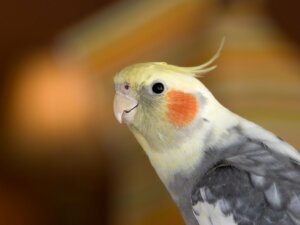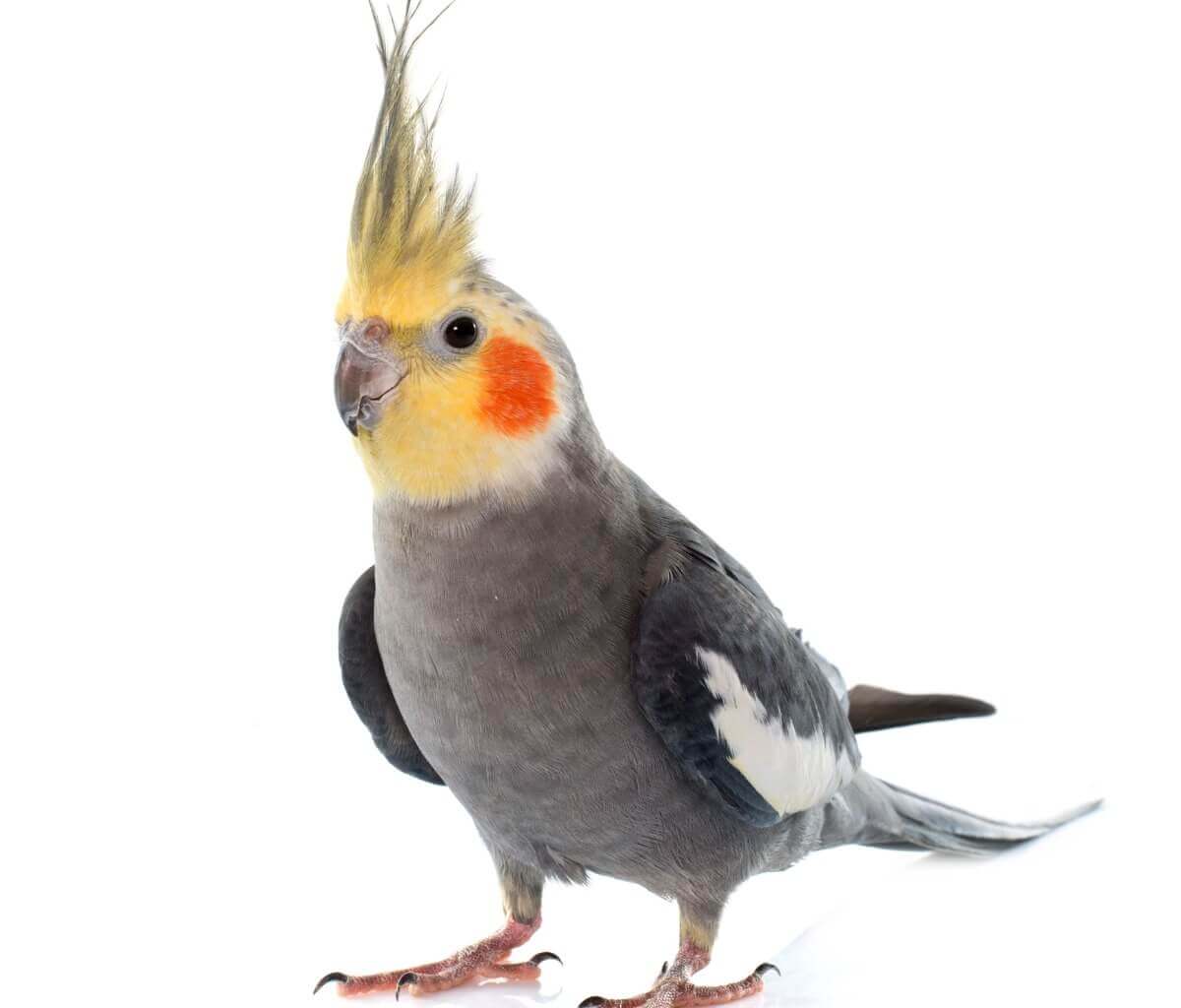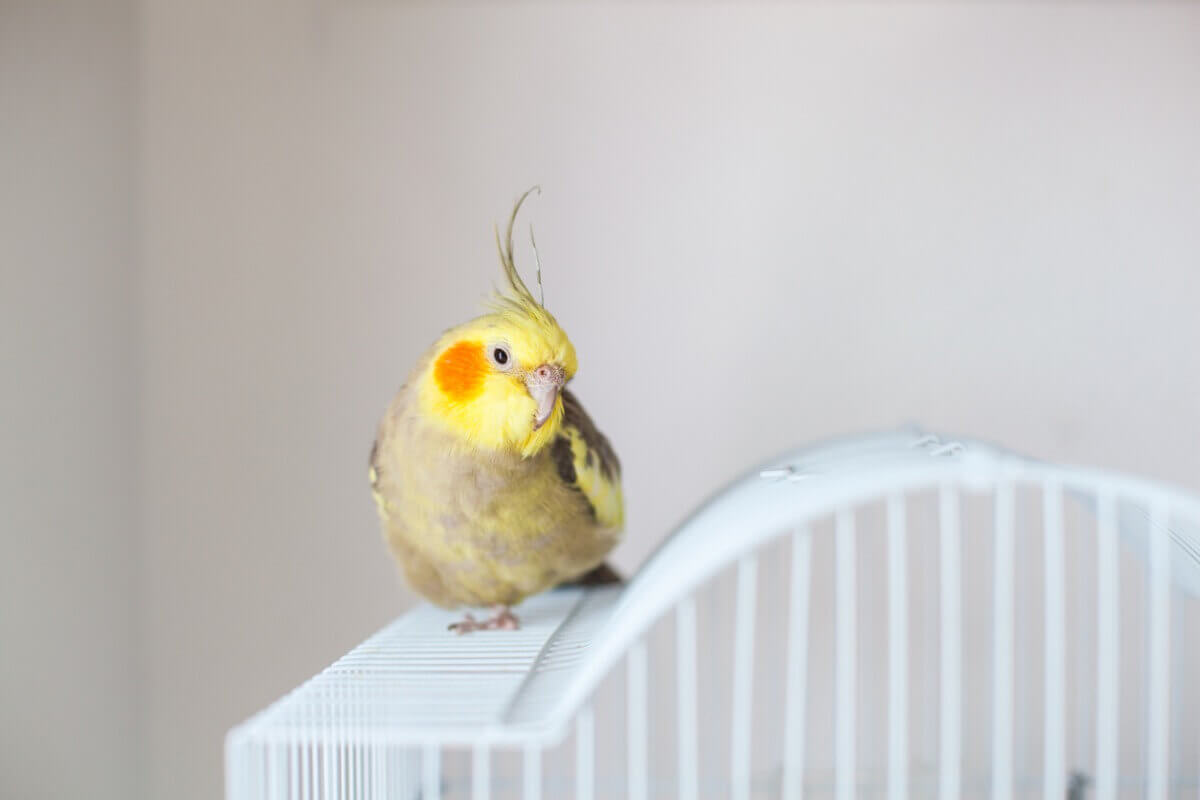The Behavior of Cockatiels

Are you interested in discovering the behavior of cockatiels? These birds are an inexhaustible source of company and entertainment. However, this species is a sensitive, sociable, and psychologically complex bird. To live with it, you need to know how to properly interpret its behavior or. Otherwise, various disorders may appear.
Each cockatiel has its own personality and peculiarities when it comes to expressing itself. However, in this article, you’ll find the basic signs for any specimen of this species, as they’re the behaviors that all of them display in their life in freedom. Don’t miss out.
Nymph characteristics
The cockatiel (Nymphicus hollandicus), weiro bird, quarrion, or nymph, is a species of parrot from the cockatoo family. It’s important to note that it’s the only living species of its genus (Nymphicus).
Cockatiels are widely distributed across the Australian continent, predominantly in the interior areas. They prefer open areas with available water or wooded areas that aren’t too dense. In addition, cockatiels migrate from north to south of the Australian continent, looking for stable weather patterns throughout the year.
These birds have a life expectancy of 15 years. Their approximate size is 10 to 12 inches counting the tail, and they weigh around 3 ounces. Based on these figures, we can say that it’s the smallest species of cockatoo that exists.
The cockatiel’s favorite food is seeds, which they pick up from the ground and peel easily with their curved beak. They also consume them on the branches together with other plant matter, as in the ground, they’re vulnerable to possible attacks. The treetops, in addition to food, provide protection against aerial predators.
The character of the cockatiels
Nymphs are highly gregarious birds, forming groups of more than 100 specimens, even 1000. Being prey animals, they’re suspicious and sensitive, with a strong tendency to flee rather than to fight.
In addition, they’re very noisy animals. Yelling and screaming are part of their daily interaction, so there’s no point scolding them loudly when they live with humans. They probably find it funny and scream even more.
Finally, you should note that nymphs are curious by nature and very intelligent. They like to inspect everything within their reach and are always looking for new stimulation. In fact, in captivity, they can develop mental health problems if they lack environmental enrichment.

Cockatiel communication
The language of these parrots has 2 main components, which are verbal and non-verbal. The first consists of different vocalizations:
- Contact calls: Birds call each other and respond in order to make sure everyone’s okay.
- Screams: They usually express anger and are accompanied by threatening gestures.
- High-pitched squeals: These can be signs of stress, fear, or pain. They serve as a warning to the rest of the flock of possible dangers.
- Songs and mating chirping: Exclusive vocalizations of the pre-copulation ritual.
- Chattering: These are soft vocalizations that these birds emit when they’re comfortable with a partner. They last a long time and usually indicate tranquility.
- Hissing: Similar to the hiss of a cat, usually preceded by a peck. It’s a warning sign.
The intensity and tone of these sounds vary depending on the emotional charge that the nymph wants to give the message. To interpret them properly, they must be integrated with the different movements and postures of the bird. We’ll show you some very useful guidelines in this area:
- Crest: This is a clear indicator of the level of emotional activation of the cockatiel. The higher it is, the more excited the bird will appear, but it’s important to distinguish the reason — it may be fear, joy, interest, or irritability.
- Feathers: Depending on the other signs, ruffled feathers can be a sign of relaxation, illness, or imminent attack. If they stick them to the body, they’re usually experiencing fear.
- Wings: Spreading them in the shape of a heart is part of the courtship of males. Opening them completely can be a sign of aggressiveness or territoriality.
- Body Posture: The variety in this section ranges from tucking their head under the brim — usually to sleep — to grooming, to jumping for joy. When they hang upside down on the branch they express territoriality.
- Head: Approaching its partner with the head down usually indicates that the specimen wants attention and grooming. Standing up, on the other hand, can be a threat — to appear bigger — or indicate surprise and fear.
- Pupils: Dilated pupils indicate irritation and a possible attack.
The behavior of cockatiels
The 3 great pillars of the behavior of cockatiels are gregariousness, intelligence, and communication. They spend most of the day looking for food, but with such large groups, they need to coordinate effectively. For this reason, hierarchy is often used when resources are scarce.
The behavior of cockatiels when it comes to reproduction
Cockatiels are monogamous and create stable relationships with the same partner, even outside of the breeding season. This allows them to save the enormous energy expenditure of finding a breeding partner each year. Before mating begins, both sexes display specific ritual behaviors, such as the following:
- Females emit low peeps while holding their tail feathers upright. By doing so, they show that they’re ready for copulation.
- Males show a greater variety of behaviors: Their vocalizations are much more intense, with more complex and song-like whistles. They accompany these sounds with a dance in which they walk with their wings upright and away from their bodies, rapidly striking a surface with their beaks. They also inspect the cavity in which they’ll establish the nest.
The care of the young and the incubation process are carried out by both sexes in equal parts. Once the chicks hatch, they take turns bringing food and never leaving the nest alone. In fact, the success of the couple raising young to adulthood directly affects the stability of their relationship.
The behavior of cockatiels in the presence of illness
Any cockatiel behavior that’s out of the ordinary and that appears suddenly is considered abnormal. Typically, this is a symptom of physical or mental illness, often closely related to stress and anxiety, especially in captivity. The most common signs of psychological stress are the following:
- Stereotypies: Repetitive movements with no apparent function.
- Pecking: The bird plucks its own feathers – or those of a fellow bird -, leaving bald spots on the body. It differs from the normal falling out of feathers in that, in this case, those in the head region don’t fall out because it can’t reach them.
- Constant screaming: these are not usual calls for attention, but high volume vocalizations that do not stop. It can also be a sign of physical pain or illness.
- Sudden or more intense aggression or fear than usual.

Keeping these birds in captivity is possible with proper care, since they are also not in danger of extinction. However, the incidence of psychological problems associated with the deprivation of liberty is high —even though there are the best of intentions along the way. For this reason, before considering adopting a nymph, it is necessary to seriously study if her life is going to be full and happy.
All cited sources were thoroughly reviewed by our team to ensure their quality, reliability, currency, and validity. The bibliography of this article was considered reliable and of academic or scientific accuracy.
- Spoon, T. R., Millam, J. R., & Owings, D. H. (2006). The importance of mate behavioural compatibility in parenting and reproductive success by cockatiels, Nymphicus hollandicus. Animal Behaviour, 71(2), 315-326.
- Seibert, L. M., & Crowell-Davis, S. L. (2001). Gender effects on aggression, dominance rank, and affiliative behaviors in a flock of captive adult cockatiels (Nymphicus hollandicus). Applied animal behaviour science, 71(2), 155-170.
- Liévin-Bazin, A., Pineaux, M., Clerc, O., Gahr, M., von Bayern, A. M., & Bovet, D. (2018). Emotional responses to conspecific distress calls are modulated by affiliation in cockatiels (Nymphicus hollandicus). PloS one, 13(10), e0205314.
- Nymphicus hollandicus (cockatiel). (2021). Animal Diversity Web. https://animaldiversity.org/accounts/Nymphicus_hollandicus/#food_habits
This text is provided for informational purposes only and does not replace consultation with a professional. If in doubt, consult your specialist.